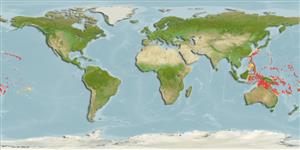Common names from other countries
Environment: milieu / climate zone / depth range / distribution range
Ekologi
laut berasosiasi dengan karang; kisaran kedalaman 2 - 400 m (Ref. 1602). Tropical; 32°N - 24°S, 117°E - 143°W (Ref. 57368)
Pacific Ocean: Philippines and Indonesia to the Tuamoto Islands, north to southern Japan, south to the Great Barrier Reef.
Size / Weight / umur
Maturity: Lm ? range ? - ? cm
Max length : 35.0 cm TL jantan/; (Ref. 9710)
Duri punggung (Keseluruhan (total)): 6 - 7; duri punggung lunak (Keseluruhan (total)): 14-15; Duri dubur 2; Sirip dubur lunak: 9 - 11.
Hides during the day and venture out at night to feed, tending to occur along steep drop-offs near caves on dark, moonless nights. Feeds on zooplankton. The large, deep water form is occasionally collected by fishing at depths of 200 to 400 m. Caught with cast nets in shallow waters of the Philippines. Forms aggregations (Ref 90102).
Life cycle and mating behavior
Kematangan | Reproduksi, perkembang biakan | Pemijahan | telur-telur | Fecundity | Larva
McCosker, J.E. and R.H. Rosenblatt, 1987. Notes on the biology, taxonomy, and distribution of flashlight fishes (Beryciformes: Anomalopidae). Jap. J. Ichthyol. 34(2):157-164. (Ref. 5004)
Status IUCN Red List (Ref. 130435)
CITES (Ref. 128078)
Not Evaluated
ancaman kepada manusia
Harmless
penggunaan manusia
Perikanan: tidak ada kepentingan; Akuarium: Komersial; umpan: occasionally
informasi lanjut
AcuanBudidaya airprofil budidaya airStrainGenetikaElectrophoresesDiturunkanPenyakit-penyakitPengolahanMass conversion
mitraGambarStamps, Coins Misc.Suara-suaraCiguateraKecepatanTipe renangArea insangOtolithsOtakPenglihatan / visi
Alat, peralatan
laporan khas
muat turun XML
Sumber internet
Estimates based on models
Preferred temperature (Ref.
115969): 17.9 - 27.8, mean 24.1 (based on 244 cells).
Phylogenetic diversity index (Ref.
82804): PD
50 = 1.0020 [Uniqueness, from 0.5 = low to 2.0 = high].
Bayesian length-weight: a=0.01122 (0.00514 - 0.02450), b=3.04 (2.87 - 3.21), in cm Total Length, based on all LWR estimates for this body shape (Ref.
93245).
Trophic level (Ref.
69278): 3.4 ±0.45 se; based on food items.
Fishing Vulnerability (Ref.
59153): Low vulnerability (25 of 100).
